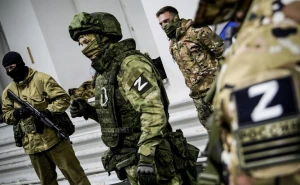
Biden shows readiness to cross Putin’s red lines
Despite threats that arming Ukraine will start a world war, President Biden continues to push the Russian leader’s limits
President Biden’s decision last month to help Ukraine get F-16 fighter jets marked another crossing of a Russian red line that Vladimir Putin has said would draw Washington and Moscow into direct conflict, the Washington Post reports.
Despite Russian President Vladimir Putin's predictions, the US has agreed to provide Ukraine with Javelin and Stinger missiles, HIMARS MLRS, advanced missile defense systems, drones, helicopters, M1 Abrams tanks, and, shortly, fourth-generation fighter jets.
A fundamental reason for dismissing Putin's warnings, according to US officials, is a dynamic that has existed since the beginning of the war: Russia's president has failed to follow through on promises to punish the West for giving arms to Ukraine. His bluffing has given US and European officials some hope that they may continue to do so without serious consequences, but to what extent remains one of the conflict's most dangerous unknowns.
“Russia has devalued its red lines so many times by saying certain things would be unacceptable and then doing nothing when they happen. The problem is that we don’t know the actual red line. It’s in one person’s head, and it can change from one day to the next,” Maxim Samorukov, a Russia expert at the Carnegie Endowment for International Peace, said.
According to US sources, one of the most difficult components of the battle for Biden and his foreign policy advisers is controlling the potential of escalation. According to officials, while determining what new military systems to offer Ukraine, they consider four essential considerations.
“Do they need it? Can they use it? Do we have it? What is the Russian response going to be?” a senior State Department official said on the condition of anonymity.
According to a White House official, White House National Security Advisor Jake Sullivan has also considered the benefits of delivering more lethal equipment to Ukraine as outweighing the risks of escalation and has worked intensively with European allies on providing F-16s to Ukraine.
Putin warned at the start of Russia's invasion in February that any country that attempted to impede his soldiers must know that the Russian response will be immediate and lead to consequences you have never seen in history.
As the war stretched on, Putin and his subordinates' warnings became more ominous, predicting a nuclear war if Russia suffered setbacks on the battlefield.
According to US sources, the losses of Russia's military could explain Putin's hesitation to strike the West.
“It would not seem to be in their interest to get into a direct confrontation with NATO right now. They are not well positioned to do so,” the senior US official noted.
In a recent interview with Foreign Affairs, General Mark Milley, chairman of the Joint Chiefs of Staff, estimated that Russia had suffered up to 250,000 dead and injured since its full-scale invasion began – astonishing numbers for any combat.
According to the general, Putin has replaced them on the battlefield with reservists who are poorly led, equipped, sustained, and not well trained.
Nonetheless, US officials are concerned that Russia, which has the world's largest nuclear arsenal, would escalate in Ukraine or elsewhere.
As the Biden administration considered such concerns, Ukrainian leaders, particularly Zelenskyy, publicly expressed their dismay. They believe that the apparent dithering and delay has prolonged the bloodshed by impeding Ukraine's capacity to overwhelm the Russian troops and force an end to the war.
Meanwhile, Republicans in Congress have stated that the prospect of Russian aggression should not even be considered. The head of the House Foreign Affairs Committee, Michael McCaul, has criticized the administration 'cowardly' for not providing tactical missile weapons known as ATACMS.
“Every time the administration has delayed sending Ukraine a critical weapon system, from Stingers to HIMARS to Bradleys, over fears of Russian escalation, they have been proven completely and utterly wrong,” he said earlier this year.
The Pentagon is thought to be more wary than the White House or State Department about delivering more sophisticated equipment to Ukraine, but officials there deny that fear of escalation is a factor in their calculations.
According to a senior Pentagon official, the Defense Department has concentrated on what Ukraine requires at any given time. The official described how the US transitioned from providing anti-armor missiles like the Javelin when it was clear that columns of Russian military vehicles would invade, to sending artillery as the war shifted into a bloody duel waged from trenches — and to more recent Western commitments of tanks and F-16 fighter jets.
Without a doubt, the Biden administration's willingness to go against Putin's red lines has strengthened Ukraine's ability to defend itself and reclaim land in the east and south. What remains to be seen is whether Putin will continue to enable the West to ignore his threats without repercussions.
“Certain red lines exist,” said Alexander Gabuev, director of the Carnegie Russia Eurasia Center in Berlin, “… but because we don’t have a way to know for sure what they are, that’s what creates risk.”
- News














































